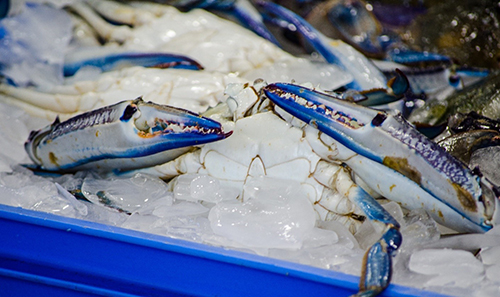Blue Swimmer Crabs (Portunus armatus) are highly prized among commercial and recreational fishers and new FRDC-funded research outlines strategies to support compliance and maintain the resource for all sectors.
Western Australia’s Peel-Harvey Blue Swimmer Crab fishery and the Blue Swimmer Crab fishery in South Australia are the focus of new research into recreational fishing behaviour and compliance.
It brings together fisheries compliance data from state authorities and a purpose-built online survey of stakeholders, including fishers, to inform compliance strategies and community education programs.
The project is an initiative of the FRDC Human Dimensions Research Coordination Program and has been led by University of Western Australia criminologist Dr Jade Lindley. Its final report recommends a range of initiatives to encourage compliance with fishing regulations among the public.
Recreational fishing catch
Commercial Blue Swimmer Crab fisheries in Western Australia and South Australia are tightly regulated, including catch quotas. However, the quantity of crabs taken through recreational fishing is more difficult to assess as neither state has recreational fishing licences.

Blue Swimmer Crab (Portunus Armatus) is a highly sought-after recreational catch species.
Blue Swimmer Crabs are accessible from shallow waters, they don’t require expensive equipment or boats, and the species is a relatively easy and rewarding catch.
Jade says that the research indicates that while there are incidents of noncompliance in the recreational catch of Blue Swimmer Crab, fishers are keen to contribute to a sustainable fishing effort.
Results from the anonymous surveys, for example, show clear support for tighter regulations including longer fishery closure periods and increased surveillance, along with more information and resources to encourage compliance.
Targeting education
In the absence of fishing licences, FRDC Project 2019-011 (Optimising Compliance Outcomes in Recreational Fisheries) has built a picture of the recreational fishing population in the two fisheries. Demographic data ensures the report’s recommendations around encouraging compliance are tailored to the fishers’ activities and needs.
Understanding when and where people fish is expected to help streamline surveillance efforts. The behaviours of those who don’t comply with regulations can be used to tailor regulation and/or communication education programs to be more effective.
Jade says anecdotally, many recreational anglers fish together in multigenerational family groups. This provides an opportunity for fishers to share compliance knowledge.
Younger generations, growing up amid climate change and strong conservation messaging, are highly receptive to the need for regulation, she says.
“What may have been normal for the grandparents when they were fishing in their younger days is not acceptable for the schoolkids who are learning that fish can sometimes be a scarce resource,” she says.
Focusing education campaigns on young people allows them to pass information on to family members, Jade says.
“One of the strategies recommended was really targeting school-aged children and bringing them onboard to enable them to ‘educate up’ in their communities.”
Jade states that using social media for education campaigns is a clear way of engaging younger people, but targeting technology favoured by older audiences is also important,”
Initiatives such as installing more permanent multilingual signage with QR codes linking to further information in several languages would help fishers understand regulations around allowable size and catch rates.
Support for enforcement
Jade describes such educational strategies as “low hanging fruit” and relatively easy to implement compared to legislative changes required to enact tighter enforcement measures such as increased penalties.
“A lot of our focus was more on education and ease of reporting, putting responsibility on individuals rather than coming down with a bigger stick,” she says.
Reflecting public support for enforcement measures, one of the report’s main recommendations is to make it easier for individuals to report non-compliance, through for example, a phone app.
Initiatives to help fishers themselves report breaches in real-time and without stigma would help build and support a compliance culture that would strengthen over time, further supporting the sustainability of the fishery, Jade says.
“If there’s a culture of non-compliance, people will see others not complying and think it’s okay. Whereas if we can encourage people to report and make it a non-threatening, simple process via a quick photo or video upload, then people will be more likely to report.”
Harsher non-compliance penalties could also be considered in the longer term says Jade, pointing to data analysis showing a drop in non-compliance in Western Australia in 2013 after fines were increased.
Practical application
Compliance is critical for maintaining the sustainability of the resource for the commercial and recreational sectors. It is also important for the Peel-Harvey fishery in maintaining its MSC certification – an international ecolabel denoting high sustainability standards that provides commercial fishers with a marketing edge.
“With MSC certification it's not just an option for a fishery to be well-managed, it's an obligation,” says Jade who is an expert member of a Peel-Harvey MSC working group ensuring it sustains its MSC standards.
Jade hopes governments in both states will use the projects insights to inform education and compliance strategies to manage their fisheries, and to build on discussions the research has initiated with stakeholders around issues such as closure periods and surveillance efforts.
FRDC Senior Research Portfolio Manager Dr Chris Izzo says the projects findings reflect the positive role recreational anglers see themselves having in the stewardship of the fishery.
“The sustainable management of our fisheries resources is a shared responsibility of all stakeholder groups, and these sorts of sentiments show that people want to do the right thing, which is great,” he says.
While the research was conducted specifically on Blue Swimmer Crab fisheries, the recommendations could be applied more broadly to other jurisdictions and species. Chris expects it will inform future projects looking at effective engagement and communication with the recreational sector in the management of fisheries.
Related project
2019-011: Optimising Compliance Outcomes in Recreational Fisheries
This relates to R&D Plan Outcomes 4 and 5





